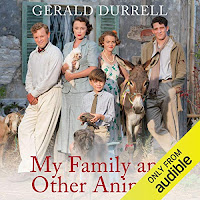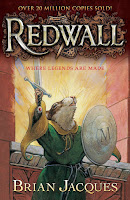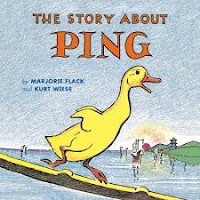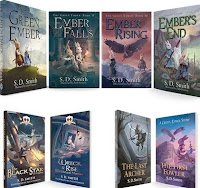The total for this month was 14 books, 4 magazines, and 0 books abandoned.
That brings the total to the year to 125 books, 36 magazines, and 6 books abandoned.
The Secret Garden (Junior Classics for Young Readers)
by Frances Hodgson Burnett
This was a condensed and adapted version of the classic story. A young orphan girl is brought to live with her uncle in England. She is told that there is a garden somewhere on the property that has been locked up for ten years since her aunt died. So, of course, she is determined to find it. She also discovers mysterious noises in the large house and eventually discovers her uncle's invalid son. Both children are spoiled, but learn to be friends and the boy learns to walk and be well. It would be a nice story except for their belief that chanting and "magic" made the boy well. I wasn't impressed with this story.
Redwall
by Brian Jacques
An evil rat and his horde attacks an abbey full of mice and other woodland creatures. A young, bumbling apprentice goes on a search for a famous sword and shield that belonged to the founder of the abbey a long time ago. After he finds it, he finally manages to kill the evil rat and save the abbey. Lots of fighting, killing, cruelty, and callous violence. Also a lot of "hell" and "devil" used as expletives. Perhaps I've been spoiled by the quality of The Green Ember and The Wingfeather Saga, but I was not favorably impressed with this story. There didn't seem to be any clear motive for why the evil rat was attacking the mice: rats are natural predators of mice (as the birds of prey are to the rabbits in The Green Ember), nor was there any backstory as to why he might have a grudge against them (as the villain in The Wingfeather Saga had). The whole story reminded me of the writing of a stereotypical boy: full of blood and guts and killing off characters right and left. It may be an adventure story, but I didn't really get what the point was to all of it. Not worth 350 pages, nor 21 more books in the series (in my opinion).

Who Was Alexander the Great?
by Kathryn Waterfield
A good biography for kids about Alexander the Great. Lots of sidebars with helpful background information.
Hannibal : Rome's Worst Nightmare
by Phillip Brooks
A good biography for kids about Hannibal and his march on Rome. Good also for adults who want a brief introduction to the this man we've all heard of but don't really know much about.
Cold-Case Christianity For Kids
by J. Warner Wallace
Written in an engaging detective story format, this book teaches kids some basics about how to search for and examine evidence for mysteries and for questions about Christianity. In this case, examining the evidence for the resurrection of Jesus.
Forensic Faith for Kids
by J. Warner Wallace
A follow-up to Cold-Case Christianity, this book examines the question of whether Jesus ever claimed to be God.
The Eagle of the Ninth
by Rosemary Sutcliff
Historical fiction set in Britain in the 100s A.D. when Britain was under Roman rule. A young centurion sets out to find and retrieve the standard of his father's legion, which disappeared without a trace 12-15 years before in what is now Scotland. There were some names and terms and allusions that I didn't fully understand, but that didn't interfere with following the plot. I wasn't sure I would like this book, but I was pleasantly surprised at how interesting and enjoyable it was.
Broken Minds : Hope for Healing When You Feel Like You're "Losing It:
by Steve and Robyn Bloem
Husband and wife authors describe their experience with his severe depression which struck just as he had finished preparing to be a pastor and was searching for a church to pastor. They make the case for the biological roots of many types of mental illness, including depression, explaining how malfunctioning brain chemistry plays a role. They critique the responses of many Christians, who are skeptical of calling depression an physical illness needing medical treatment. It was insightful to get a glimpse into the experiences of one who has suffered much with depression and of the family who sought to help and support him.
Here Burns My Candle
Mine is the Night
by Liz Curtis Higgs
A retelling of the Biblical story of Ruth and Naomi. This is set in 1745 in Scotland, during the Jacobite rebellion attempting to restore the Stuarts to the throne (think Bonny Prince Charlie). I liked the history part, and the idea of retelling the Ruth/Naomi story was intriguing. It had the potential for being a wonderfully redemptive story and a good history lesson in the bargain. Unfortunately, the author chose to spend much time and detail on the adultery of the Ruth character's first husband, as well as the obsession and lust of other male characters. She spent very little time developing the spiritual lives of the Ruth, Naomi, and Boaz characters. She didn't really explain sufficiently how the Ruth character went from a pagan moon worshipper to having faith in "the Almighty": the character read from the Psalms, but no other part of Scripture. Notably missing was any reference to Jesus and very little to any of the New Testament. If the author had left out all the sexual stuff and delved into the spiritual lives, it would have been a wonderfully redemptive story, like the original account.

My Family and Other Animals
by Gerald Durrell
A hilarious, laugh-out-loud-funny account of the English author's childhood spent on the Greek island of Corfu with his family. He describes adventures with various animals, neighbors, and of course his eccentric family. The narrator was fantastic -- great voices and accents. Unfortunately, there was a lot of language (using God's name in vain, mild cursing) and some sexual innuendos. Because of that, I wouldn't read it again.
The Victorian Christmas Brides Collection
by various authors
A collection of nine short stories, set in the mid- to late 1800s. Several were sweet heart-warming stories of reconciliation and friendship, some were so-so, and one was very poorly written (all dialog, no background to explain what's going on). All very improbable -- going from hostility to engagement or marriage in a matter of days or at most months. Maybe it would have been better to spread the nine stories out over a longer time, but reading them one after the other made them seem all the more improbable and ridiculous.
The Young Carthaginian
by G. A. Henty
Tells the story of the war between Carthage and Rome, including Hannibal's invasion of Italy across the Alps through the eyes of Hannibal's younger cousin, Malchus. More interesting than a plain history book, not quite as can't-put-it-down as a pure fiction/adventure book. Still, it's a good way to get a little deeper into the history. It helped that I had read another, simpler book about Hannibal first. There are a lot of descriptions of battles (especially the tactics and strategies) and hunts. Not too gory.
Beautiful Stories from Shakespeare
by Edith Nesbit
A retelling of some twenty of Shakespeare's plays, in a prose format aimed at children. Conveys the gist of each story without the flowery language and other details that are not appropriate for children. I listened to the audiobook. I thought it was nicely done (both the content and the narration). It was enough to give me a taste of Shakespeare (beyond the Romeo and Juliet we had read in high school). I can't say that the topics and themes that Shakespeare featured are particularly interesting to me, so I don't expect I'll go farther with it than this. We may listen to a few selections from this when we get to this time period in school.











































